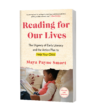Emphatic and unsparing, Kiese Laymon’s Heavy explores the weight of wellness in a culture obsessed with lean. His expansive intelligence and fluid prose bear up to haunting family secrets and American deceptions with deep, potent wells of beauty, humor, and empathy.
Initially conceived as a weight-loss story chronicling his family’s struggles with food and violence, the writing of Heavy, which was recently named a finalist for the 2018 Kirkus Prize for Nonfiction, got murkier when relatives sidestepped his interview questions or lied altogether. “We’re a family, like most families, of addicts, but we never talked about the addiction,” he says. “We would talk about losing weight or gaining weight but we never talked about why. We never talked about particular memories around domestic, sexual, and racial violence.”
He became convinced that no one in his family wanted to reckon with the weight of where they had been or do the work of freeing themselves of it. “You need to keep that for your journal,” his mother would say of the revealing material he wished to mine for the book. “Nobody else needs to see that kind of writing.”
Click here to read the full post at KirkusReviews.com.
I would like to designate December National Quitting Awareness Month. After reading Seth Godin’s The Dip: A Little Book That Teaches You When to Quit (And When to Stick), I’m fired up to pare down before the New Year.
The slim volume argues that quitting (despite its poor reputation) is a key to success. Quit fast. Quit often. Quit without guilt, Godin urges. Because quitting worthless pursuits gives you the time, energy, and focus to obsess about something that matters.
“Just about everything you learned in school about life is wrong, but the wrongest thing might very well be this: Being well rounded is the secret to success,” he writes. “In a free market, we reward the exceptional.” And the exceptional have learned to quit strategically.
Godin argues that when you trade busyness for obsession, you win. When you spot a dead end a mile away and reverse course, you win. Never underestimate the costs of staying stuck, he warns. Dead-ends are not neutral. Idling burns gas and keeps you from going somewhere exciting. Quitting unworthy projects, investments, and endeavors is the shortcut to success.
Most people quit reactively. “They quit when it’s painful and stick when they can’t be bothered to quit,” he writes. His advice? “The next time you catch yourself being average when you feel like quitting, realize that you have only two good choices: Quit or be exceptional. Average is for losers.”
The “dips” that the book’s title refer to are the exceptions to the quitting rule. Unlike dead ends, Godin’s dips are temporary. They’re the barriers that thwart most but reward those who tough it out. “Your marketplace is competitive, filled with people overcoming challenges every day,” Godin writes. “It’s the incredibly difficult challenges (the Dips) that give you the opportunity to pull ahead.”
He’s talking about entrepreneurship, but we can apply the insight to any period when our motivation is tested and our resources are stretched for our good. If excellence were easy, everyone would do it, and no one would profit, he insists.
Godin does advocate some quitting when laboring through a dip. Quit tactics, products, and features without hesitation while staying true to your market, he advises. The larger aim is to be a trusted source to a specific audience, not to foist an unwanted product on it. “Don’t fall in love with a tactic and defend it forever,” he writes. “Instead, decide once and for all whether you’re in a market or not. And if you are, get through that Dip.”
After reading The Dip, I’m examining all of my activities and deciding which are worthy of my time and talents. The resentment and fatigue that accompany some are sure signs that it’s time to move on. Cutting my losses, I now see, will give me the resources I need to tough out the dips in the commitments that matter. Why cope when you could quit? Why muddle along when you could push through?
Have you been stuck in a rut with work, personal, or volunteer projects this year? How do beliefs about quitting shape your decisions to continue or discontinue activities? Are some things easier for you to quit than others? If so, why?
Quote to Remember
“A woodpecker can tap twenty times on a thousand trees and get nowhere, but stay busy. Or he can tap twenty thousand times on one tree and get dinner.” – Seth Godin
The Texas Book Festival launched by former librarian and then First Lady of Texas Laura Bush and philanthropist Mary Margaret Farabee in 1995 continues to grow in size and impact. Today the literary event brings more than three hundred authors to Austin each fall for a weekend of thought-provoking book discussions. What’s more, its book sale proceeds and attendee donations support powerful student programs in schools throughout Texas year-round.
One of those programs is Reading Rock Stars, which sends noted authors into Title I schools to inspire kids with great books and powerful live presentations. To date, the program has facilitated more than 400 author visits to Title I elementary schools in Austin, Dallas, Fort Worth, Houston, and the Rio Grande Valley, and distributed more than 100,000 autographed books to students at those schools.
The newer Real Reads program serves middle and high school students in similar fashion, pairing close readings of urgent books with deep conversations with their authors. Participating authors include Kwame Alexander, Matt Mendez, Jason Reynolds, Erika Sánchez, Nic Stone, Angie Thomas, Jacqueline Woodson.
I recently spoke with Lea Bogner Loy, who, as the outreach manager for the festival from 2017 to 2019 expanded Reading Rock Stars and launched Real Reads. We discussed what separates these programs from other author visits, why kids need to see themselves in books and authors, and what she hopes her Texas Book Festival legacy will be.
What was the most meaningful part of your Reading Rock Stars experience for you?
I think the focus I brought to the program on working with authors of color. I just saw what a difference it made when the students saw an author that looked like them up there. How much they really connected with the book. I also saw how grateful librarians were because they always felt like they struggled so much to find books that related to their kids. And so for me, being able to give a platform to those authors, and also give kids that experience, was really meaningful.
What are some of your favorite Reading Rock Stars memories?
Oh man, so many. There was one in the Rio Grande Valley with Ying Chang Compestine, presenting [her book The Chinese Emperor’s New Clothes] to PreK, K, and 1 students. She was talking about how she was an immigrant and all the kids were saying how they were immigrants too. There was that moment of cross-cultural understanding that was really special.
And there were always moments where kids would say, “I get to keep this book?” or “I’ve never had a book before.” That happened at every school we went to and every time it was always a gut punch. It was a reminder that we were doing important work.
During your tenure, you also launched the Real Reads program for middle and high school students. Why was it important to you to provide author programming for older students?
I think there’s a magic of reading that starts to get lost as you get older, especially for the students who aren’t seeing themselves in books. It’s an issue across the board. I remember being in school thinking “I can’t read The Grapes of Wrath or Shakespeare anymore. I want to read something that’s relevant and interesting to me.”
When you don’t have any reason to get connected to a book, you’re just not going to read as much. And it’s so important to continue to read—not only for vocabulary acquisition or to do well on standardized tests, but to be connected to modern issues.
And so that’s what Real Reads did. It gave students books that were really interesting to them and relevant, but that were also connected to things that they were seeing in the news and dealing with on a personal level. So they were able to really bring it all together and ignite that spark for reading.
I think people, especially literacy programs, have started to write off older students and think that they’re kind of a lost cause by the time they get to high school. And I really disagree with that.
What do you hope your Reading Rock Stars legacy will be?
Legacy is a big question. There are two parts of it. One is you’re just getting kids excited about reading, which so many authors are great about. But I think in publishing and in charity it’s easy to fall into the white savior complex of “I’m going to do these nice things for these kids of color and it’s going to change their lives.” If we’re not more intentional about it, it’s not going to make the kind of impact that it should.
I hope my legacy is that this program is not only about showing kids that reading is fun and important, but that they deserve books and that they’re empowered to do whatever it is they want to in their lives.
When I was in the classroom, the curriculum that was given to me was all about young white boys and 100% of my students were black. It was heartbreaking. Kids deserve to see themselves in books and if I had the platform to be able to bring a book to a child, I wanted to make sure that either it was going to be really funny and make them really love reading or they were going to see themselves in the book and feel empowered and seen.
This interview has been edited for brevity and clarity.
Learn More About Reading Rock Stars and Real Reads
Pronouns just aren’t what they used to be. Apparently, new uses of the word they sent people to the dictionary in droves in 2019. Online searches for the word spiked 313% from the year before. And the upsurge in curiosity about the 600-year-old word lead dictionary giant Merriam-Webster to name they the word of the year.
We’ve long thought of they as referring to groups of people, animals, or things. Or even (though more recently) to singular people if their identities aren’t known or specified. For example, “the person who answered the phone said they didn’t know when the homeowner would be available.”
New to the scene is using they to refer to an individual person whose gender identity is nonbinary or unknown. The usage bubbled up from personal prerogative to the media to professional organizations. “The American Psychological Association now recommends that singular they be preferred in professional writing over he or she when the reference is to a person whose gender is unknown or to a person who prefers they,” dictionary editor Peter Sokolowski said. “It’s also increasingly common to see they as a person’s preferred pronoun in Twitter bios, email signatures, and conference name tags.
Merriam-Webster added this nonbinary sense of the word to its dictionary in September. And chose an excerpt from a New York Times article to illustrate the usage. “They had adopted their gender-neutral name a few years ago, when they began to consciously identify as nonbinary—that is, neither male nor female,” journalist Amy Harmon wrote. “They were in their late 20s, working as an event planner, applying to graduate school.”
So why should we care? Because words matter. The language we use to express ourselves and learn from others demands attention in thought and use. In this case, the care with which we use the word they speaks volumes about our willingness to accept people on the terms they’ve chosen. When we call people by the pronouns they prefer, we use language in the service of human connection.
Perhaps pronouns aren’t what they used to be because we are more complex than we once acknowledged. Maybe our language is evolving to reflect greater understanding—and acceptance.
Have you noticed an uptick in new uses of the word they? Did you look it up in the dictionary to check for new insights or understanding? Can you think of other words that are changing in meaning or use?
Sources and Further Reading
https://www.merriam-webster.com/dictionary/they
I marvel at book talk attendees. People trek from great distances, clutching worn copies of favorite reads. They stand in long lines for a brief word with (or autograph from) a favorite writer. The brave ones step to the podium to share stories or ask questions. Their remarks bring more voices and perspectives into conversation. Their contributions add welcome depth and texture to the occasion.
At a Jacqueline Woodson BookPeople talk that I moderated in October, an educator in the audience asked, “What has been your hope, as a writer yourself, that your children’s teachers would do for them in the area of reading and writing?”
I loved the question, and Woodson’s eloquent answer. She spoke about celebrating all reading and giving kids the time and books they need to find their own pathways into literature. We all should listen.
Her response, word-for-word:
That’s a great question. What is my hope that my children’s teachers do for them in the area of reading and writing? I hope they let them read slowly. I hope they let them read whatever they want.
You know, I was in fifth grade reading picture books and people felt some kind of way about it. I remember, back in the ’90’s and early 2000’s, the pushback against graphic novels. My son read graphic novels forever and what cracked the code for him to read other books was to continue to read graphic novels and The Outsiders in fifth grade. He had a really great teacher that taught that book so slowly, so, so slowly, and the reward was they could watch the film at the end of it.
Letting them read what they want, letting them read slowly, and having, when they can afford to, really diverse classroom libraries. I’ve gone into classrooms where the kids have been all white and the books have been all white and I’m like, that’s not helping anybody, especially me, for when they first meet me and don’t know what a black person is. But, just having those diverse books, not only in terms of race and gender stuff and sexuality, but in terms of economic class and in terms of readability, you know, the different reading levels.
So, when my kids were younger, whenever I was looking for a new school for them, the first thing I would do is go into the classroom library and then, if there was a school library, into the school library. But, really, so many books, even if there’s not a classroom library, there’s a public library, there’s First Book. There are all these organizations that are able to help teachers get those books into their classrooms if they don’t have the funding for them. That’s what I would love.
And all reading is celebrated. When kids are in different reading groups because they read at the lower level or at the higher level, they know that. I wouldn’t mind if that didn’t exist anymore. I’ve talked for a long time about getting rid of that term, “struggling readers.” They know when someone considers them a struggling reader. So how do we talk about them being where they are and where they are is okay?
Culture Queen Discusses Top Kwanzaa Misconceptions
Got questions about Kwanzaa? You’re not alone. Here’s Kwanzaa educator Jessica
“Culture Queen” Hebron’s rundown of the top five misconceptions about Kwanzaa.
Misconception 1: Kwanzaa is a Religion
Kwanzaa is a celebration of Pan-African family and community, not a religious ritual. “People think that if you start celebrating Kwanzaa, you’re devil worshiping or you’re worshiping principles instead of God. That’s not true. The principles were created to be universal for black people in America, so no matter what their religious experiences or cultural experiences, they have one thing that they can unite with—Kwanzaa.”
Kwanzaa is compatible with any family’s religious faith. “You could celebrate Kwanzaa and be Jewish and black,” Culture Queen explains. “You could celebrate Kwanzaa and be Christian and black. You could celebrate Kwanzaa and be Buddhist and black.”
Misconception 2: Kwanzaa is a Christmas Knock-off
Culture Queen cautions against dismissing Kwanzaa as a “knock off” of Christmas just because it starts on the day after Christmas. Kwanzaa “has its own principles, its own traditions, its own decorations, its own meanings and purposes,” she says. “The reason that it takes place in December is because traditionally in Africa there are a lot of harvest festivals that take place during that time. Kwanzaa is a Swahili word that means first fruits of the harvest.” The holiday’s timing has its advantages, though. “It is convenient that it’s during a time when families are already gathering.”
Misconception 3: There Are No Gifts in Kwanzaa
Contrary to popular belief, people who celebrate Kwanzaa can give and receive gifts. “Gifts during Kwanzaa, called zawadi, should be either purchased from black-owned businesses or handmade by the people who are giving them,” Culture Queen explains. “You can be so creative with that. It doesn’t mean that you’re getting some rinky-dink present.”
Misconception 4: Kwanzaa Isn’t a “Real” Holiday
“I always challenge people to treat all holidays with respect,” says Culture Queen. “There are no fake holidays. There are no holidays that aren’t serious… I find myself always advocating for people to give reverence to the holiday the same way that they would [other holidays].
“When black people, specifically, don’t treat Kwanzaa with respect, what they don’t understand is that it’s almost like they’re saying it’s not real, and because it’s not real, they aren’t real and shouldn’t be taken seriously,” she explains. “Because if you’re not going to celebrate the holiday that was created just for you, then why do you expect the world to respect and take care of you?”
“This is a holiday,” she affirms. “This is something that’s supposed to be joyous and fun for you.”
Misconception 5: To Celebrate Kwanzaa is to Celebrate Its Founder
Like many founders of historical movements, Kwanzaa’s chief architect has a controversial personal history. Maulana Karenga was convicted in 1971 of two felonies
for assaulting and tormenting women in his California home. Culture Queen draws a firm line between the founder’s history and the holiday’s positive impact. “My response to this is the same response that I would give to someone who would talk about Bill Cosby and The Cosby
Show,” she says. “What I would say is he should be ashamed of what he did. However, the holiday that he created for black people is one of the highlights of his life and one of the positive things that he did. I would like to just isolate that and leave that for what it is.”
“This holiday is now so much bigger than him,” she says. “His history and the things that he’s done don’t affect the positivity and the intent and the mission of the holiday. A lot of times people think that he owns it, and he does. But one day he won’t be here and it’ll be years and years later and people will still be celebrating Kwanzaa. The intent of the holiday will rise more so than his history.”
See the official Kwanzaa
website to learn more about the holiday. Also, check out Culture Queen’s thoughts on bringing
Kwanzaa to life and Kwanzaa
picture book recommendations.
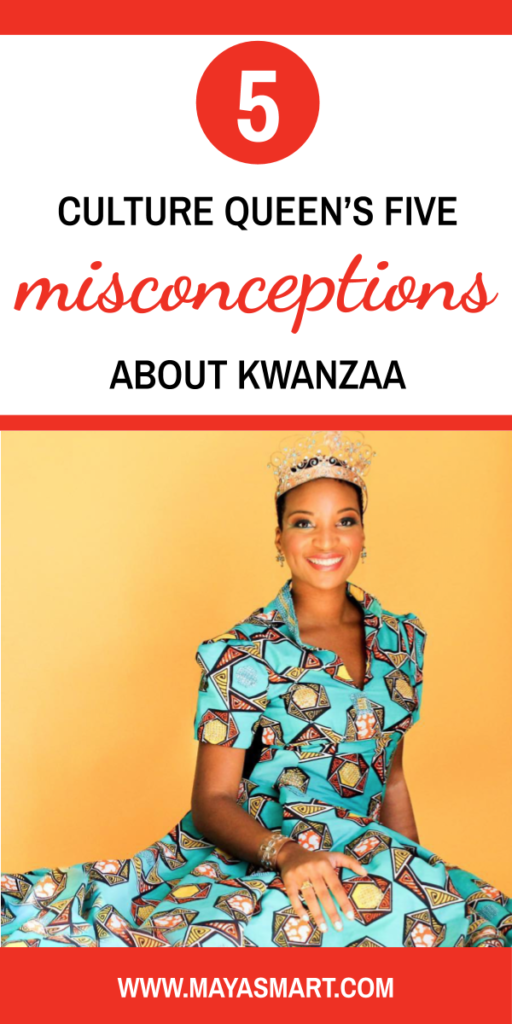
Did any of these points change your understanding of Kwanzaa? Are you more or less likely to celebrate the holiday as a result?
Culture Queen Resources
I know my opinions make an impression—among people inclined to agree with me, anyway. My confidence in influencing those with divergent views, however, is so low that I generally avoid addressing controversial issues with them at all. I wouldn’t talk guns or race with a Republican, for example. I’ve read one too many reports on partisan polarization to go there. To be fair, I’ve offered similar silence to some on my side of the aisle, too, especially the “colorblind” and others who may be well-intentioned but willfully ignorant. My pragmatism, I’ve long told myself, won’t allow wasting breath in futile debate.
But for the new year I’m open to engaging in the kind of fraught conversation I’ve typically shunned. I turn 40 this year and feel like it’s time to drive change instead of staying cloistered in a comfortable place. Dramatic shifts in public opinion on same-sex marriage, gender-neutral pronouns, and more give me hope that minds can be changed about the value of racial equality, immigration, and climate action, too. This year, I aim to learn the tools of persuasion that work and use them to do my part to fuel equity and social progress.
Though I’m still likely to avoid the aggravation of live debate, I’ve resolved to share my views more widely via regular opinion pieces and essays. Putting arguments out there, listening to the responses, and genuinely seeking common ground to pursue is perhaps the best any of us can do. What looks like sweeping change is usually hard won step by step.
To gear up to this challenge, I read Writing to Persuade by Trish Hall, a former editor of The New York Times Op-Ed Page. The book promises “techniques for bringing people over to your side not only in written arguments, but in life.” Here are a few takeaways from her distillation of scientific research on persuasion and her years of opinion editing.
Argue from the perspective and values of those you seek to persuade, not your own. “Despite our culture of selfies, persuasion is not about you; it’s about them,” Hall writes. That means you have to listen to, and understand your audience in order to influence them. Facts alone, however eloquently presented, do not move people to embrace new views. Any arguments made without listening first are likely to be dismissed or ignored. One classic op-ed approach is to start by establishing common concerns or shared values and then to bridge into areas of contradiction or disagreement. Building rapport aids readers’ receptiveness to challenging ideas. “You’re more likely to get the argument moving if you’ve agreed on some baseline issues and only then try to move it in another direction,” she writes.
Write clearly, directly, and vividly. Terrible writing of all kinds flooded Hall’s inbox during her time leading the Opinion section at The New York Times. “Manicured products of Ivy League schools offered tangled sentences and mundane musings,” she wrote. “People whose novel ideas deserved a hearing could not escape their jargon long enough to reach an audience.” To avoid these pitfalls, she advises a straightforward approach—making just one to two points and presenting them logically and intelligibly. The book offers before and after examples to illustrate the depth of pruning that’s sometimes required to achieve this.
Speak from experience. To persuade, you must bring authority. It helps to write on topics where you have deep involvement or understanding. Then you can use your singular perspective, sensibility, and knowledge to present the stories, concrete details, and vivid imagery needed to make your best case. “No matter how you get there, you have to write from your deep self,” Hall urges. “If you stay at the level of your office brain or your academic self and use the jargon of your profession, you will kill your work. You might not even know what story you want to tell until you think about what you, and only you, can offer.” Often revealing intimate, personal details makes the writers more human and the pieces more memorable and powerful.
I’ve presented a few highlights of Hall’s book, but recommend reading Writing to Persuade for the full complement of this top editor’s stories and insights. Her matter-of-fact style and rich examples cut to the heart of key topics for budding essayists: where to find great ideas and how to pursue, pitch, and develop them to persuasive effect.
She also offers helpful reminders of why we should venture opinions at all. “Engaging with the world, whether through writing or in person, is what the world is, what life is,” she writes. “We are all in this together, and our words connect us in the most primal and profound way.”
How open are you to discussing controversial issues with people who may strongly disagree with you? Why is it important to pursue common ground? Has an op-ed or personal debate ever led you to change your mind on an important matter?
I read Destination Simple: Everyday Rituals for a Slower Life by Brooke McAlaray for a new year’s reset. The tiny book can be read in one sitting, but it’s also great to dip in and out of as you let the ideas marinate.
Unlike more rigorous guides, such as David Allen’s Getting Things Done (which I also love), Destination Simple is one to reach for when you’re feeling overwhelmed—when you want to sink into your day versus power through it.
Broken into three parts, it first presents useful rituals like single-tasking, unplugging, emptying your mind, prioritizing just three things, and gratitude. Next it offers morning and evening rhythms. And finally come parting words on tilting (the opposite of seeking balance), noticing, and enjoying life. Above all, it advocates for a relaxed state of mind and ritual-guided versus schedule-dictated days.
There are no shocking revelations in the rituals section. Anyone who reads personal productivity books or blogs is well-versed in the ideas offered here. We’ve been warned of the dangers of multitasking, digital distraction, and endless to-do lists for years now (though our behavior suggests that we can still use reminders). We’ve heard all about the power of gratitude lists, mindfulness, and brain dumps.
McAlaray’s fresh idea is that adopting the seven specific rituals she highlights—plus morning and evening routines and a generous dose of flexibility—is “the easiest, most successful way to create a simpler, slower life.” It’s the combination, not the techniques alone, that make the difference.
In Part Two, McAlary makes a helpful distinction between rhythms and routines. “Routine is rigid and inflexible and makes you feel that a set sequence of events needs to happen precisely or the exercise is a failure,” she writes. “Rhythm, however, is a much friendlier notion. It speaks of order and understanding and flexibility and movement and fluidity.”
She offers examples of morning and evening flows to illustrate how you can create calm and satisfaction by thinking about what works for you, allowing sufficient time for your chosen rituals, considering others’ needs, and staying flexible. Establishing the rhythm can take a few weeks of trial and error, tweaking and changing, but the investment pays off in time-awareness.
“The beauty of this rhythm is that if certain things don’t happen (I don’t get the laundry on, for example) things don’t fall apart: I’ll just do it later,” she writes. “Similarly, if I don’t get time in my office, I know I’ve either chosen more sleep (a valid choice some mornings!) or the kids have needed me and I’ll have the same time available to me tomorrow. It’s about being organized enough—but also knowing when to let go.”
The call to fluidity made the biggest impression on me. “Tilting,” she calls it, citing a 2009 Marcus Buckingham study. Forget balance, she urges, which is “impossible to achieve, stressful to attempt and boring to live.” Instead, learn to tilt, which is to say intentionally and decisively lean into some things and lean away from others in the moment, as needed.
“We can’t be everything to everyone in every moment, and tilting makes it clear that by saying yes to one thing, we’re saying no to another in that moment,” she writes. “And what’s more, it’s OK to do so.”
Cheers to that.
Do you have any go-to books that help you rethink or reset how you organize your life and its endless stream of inputs and information? Are your days more ritual-guided or schedule dictated? How okay are you with imbalance in your life?
Filling your home with books, whether bought or borrowed, is a great way to show kids that you value family reading. And while the stories and illustrations between the covers matter most, attractively displaying the books can build excitement. I recreated the DIY Honey Bear Bookends from Pretty Providence and think they’re the perfect eye candy to bring kids’ attention to the sweet titles on your shelves.
Materials
- Two Honey Bears
- Gold Spray Paint
- Sand or pebbles to fill empty honey bears (optional)
Yes, that is really all you need! This DIY craft is as easy as 1-2-3.

Step One
Find the right spot to spray paint. I started this project in my studio with the windows open. I didn’t think I would be using a lot of spray paint and that with the open windows it would be fine to spray the bears inside. Wrong! The smell of spray paint takes over your home so quickly. So set up outside or in a garage with the door open. You don’t need a very large space to spray paint, but you will want to lay out a piece of paper or something to protect your work area. I used a scrap sheet of paper and cardboard for my overspray.
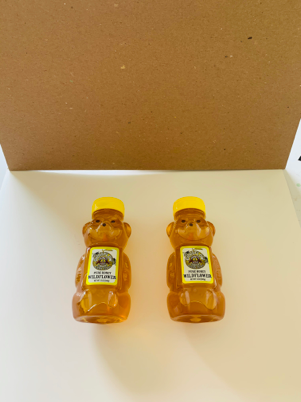
Step Two
Spray the bears evenly until they are coated with gold paint. Less is more here! It is better to do a few coats to achieve fully opaque coverage than to try to cover them in one pass, which may lead to clumping and drip marks on your final product. I found it worked best to hold the spray paint about 10-12 inches away from the bears. For the first pass, I laid the bears down (as shown in photo). Once they were dry to the touch after about 30 minutes, I carefully stood them straight up and sprayed the back side of the bears. I waited another 30 minutes and then touched up a few spots that needed a little more coverage.

Step Three
Patiently wait for the bears to dry fully. This is probably the hardest step! Spray paint can be dry to the touch in just 10-30 minutes, but it will be really, really dry in about 8 hours. So just wait! These cute bears will get very cozy with the books on your shelves, and you don’t want them to smudge their neighbors.
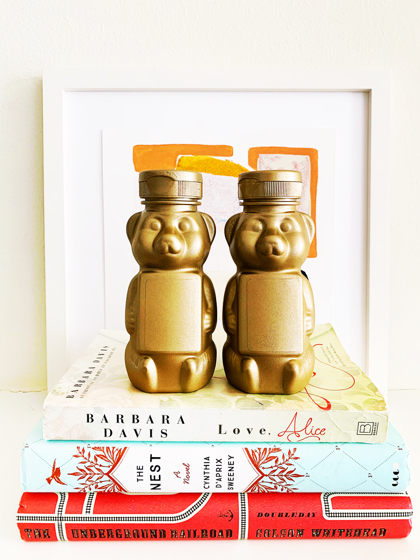
Step Four
Have fun styling your shelves! There is no right or wrong way to display your favorite reads, especially when bookended with something this adorable. Try taking everything off your shelf and rearranging the elements so that each one is in a different spot than before.
Kelsey Nickerson creates abstract paintings with rich color, texture, and movement, and enjoys a good book craft. She oversees web production and styling for MayaSmart.com.
Which of Kelsey’s shelfies are your favorite? Comment below and let us know!


Can you spell sesquipedalian? Well, the children featured in anthropologist Shalini Shankar’s Beeline: What Spelling Bees Reveal About Generation Z’s New Path to Success can. The elite competitors in the Scripps National Spelling Bee are largely of South Asian descent and, though born after 1996, exhibit intensity, skill, and poise rare in people twice their age. On stage, they spell obscure words with ease, backed by supportive parents and thousands of hours of practice.
And these feats aren’t fringe academic stunts, but bellwethers of broader Gen Z trends, Shankar argues. Namely, the escalation of digital media, academic-centered parenting styles, and unprecedented venues for public competition. When the three elements converge, kids’ journeys from students to experts go into hyperdrive—in spelling and beyond. Gen Z kids compete on television, give interviews, design apps, start up businesses, and deliver speeches like pros—far younger than their predecessors.
Shankar’s choice to focus on a slice of the South Asian American community that takes part in spelling bees is apt and revelatory. She rejects the white middle class lens typically put on generational theories and instead explores how immigration, access, and public representation shape Gen Z aspiration, motivation, and educational achievement. The Immigration Act of 1990, in particular, changed the game for U.S. parenting styles and childhood, she contends.
Like Amy Chua’s exacting “tiger moms” (without the claws and teeth), Shankar’s “bee parents” value education above all. That’s no surprise. “No other immigrant population in the history of the United States has been so carefully curated according to educational qualifications as Asian Americans,” Shankar writes. India, specifically, has supplied the majority of all skilled labor arriving in the U.S. since 1990. It follows that they would raise their kids with the same commitment to rigor and achievement that brought them to the U.S.
Then there’s the National Spelling Bee itself. It’s one of an increasing number of televised competitions—from Top Chef Junior to Shark Tank: Kid-Preneurs Edition—that put young talents on display. Its signature combination of intense cognitive demands, public speaking, and long odds of winning breeds ambition, grit, pragmatism, and appreciation for process over results. With 476,000 words up for spelling, the contest rewards intense work ethic and multiyear effort. Competitors spend thousands of hours preparing, despite knowing they are but one in 11 million annual participants.
The elite spellers Shankar examines go to extremes to improve their chances of success. They learn to read pronunciation guides, study word roots and patterns, and comb the dictionary for sport—for years. Notably, they lack a sense of entitlement that their many hours will be rewarded with championships. They value the knowledge, habits, and skills they build—whether they win or not. They appreciate who they become in the pursuit.
They may train in obscurity, but that all changes when the National Spelling Bee airs live on ESPN. The network produces snazzy features that depict the spellers, their families, practice rituals, and personal quirks. The platform makes them public figures with a personas to project and audiences to woo to advance their careers. Just ask the spellers Shankar describes who have parlayed spelling bee success into profitable apps, coaching practices, and careers.
Shankar also does a great job of illuminating the ways the spelling bee publicity enthralls new cohorts of spellers. South Asian Americans have dominated the National Spelling Bee since 2008. What’s more, nearly every family that Shankar interviewed cited Nupur Lala’s 1999 National Spelling Bee win, memorialized in the documentary Spellbound, as their inspiration for competing. When the families saw someone who shares their heritage hoisting the winning trophy on stage, it expanded their sense of possibility and ambition.
Lala in turn speaks eloquently about the numerous Indian American finalists in the 1998 bee (the year before her win) who inspired her. “There were no barriers to my success,” she recalls thinking, after seeing them. “It was profound. This was the first activity that I had participated in where my ethnicity, my gender—none of this was holding me back. I saw it as a wide-open arena.”
The elite spelling bee competitors might be kids, but they sure aren’t playing around.
Next up: Three lessons I learned from bee parents.
Do you think that childhood today is more competitive than when you were a kid? What are the pros and cons of early achievement? Aside from spelling bees, what examples have you seen of heightened childhood competition and skill-building?
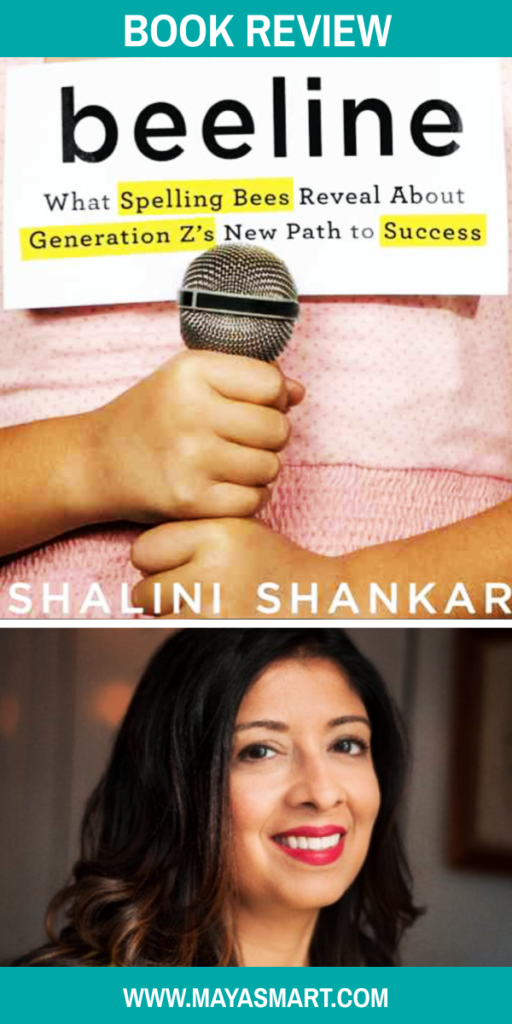
Sources and Further Reading
Shankar, Shalini, “Beeline: What Spelling Bees Reveal About Generation Z’s New Path to Success,” (New York: Basic Books, 2019).

